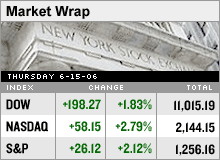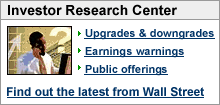|
Party on Wall Street
Major gauges surge, tripping trading circuit breakers, after Bernanke speech eases inflation jitters; Dow finishes above 11,000.
NEW YORK (CNNMoney.com) - The Dow Jones industrial average posted its best day of the year Thursday, settling above 11,000, after Federal Reserve Chairman Ben Bernanke delivered a non-alarmist speech on inflation, extending a morning rally sparked by tame economic reports. The Dow (up 198.27 to 11,015.19, Charts) jumped about 1.8 percent, while the broader Standard & Poor's 500 index (up 26.12 to 1,256.16, Charts) advanced 2.1 percent. The Nasdaq composite (up 58.15 to 2,144.15, Charts) surged 2.8 percent.
It was the biggest point and percentage gain for the Dow since April 2005, according to Jeff Hirsch of the Stock Trader's Almanac. It was the best percentage gain for the Nasdaq in over two years, and the biggest point gain in over three, he added. The S&P posted its best gains by both measures in over three years. The size and breadth of the rally led the New York Stock Exchange to institute a restriction on trading - circuit breakers that prevent the market from rising or falling too much on any given day. It also led some investors to speculate that stock's long slide over the last several weeks may finally have come to an end. "The market has been searching for a bottom for the last five trading days," said Tim Heekin, a trader at the San Francisco investment bank Thomas Weisel. "I think we put it in yesterday." Treasurys fell, oil prices made modest gains and the dollar was mixed. After the bell, Microsoft said its co-founder Bill Gates will give up his day to day role at the company in July 2008, although he will remain as chairman. Traders will await a reading on consumer sentiment and the trade deficit to move markets Friday morning. Market movers
The Fed chairman, long scaring markets with inflation speak, said that overall cost increases due to higher energy prices had been "relatively low" and that inflation expectations in the bond markets had "fallen back somewhat" over the last month, Reuters reported. "Nevertheless, these developments bear watching," the news agency quoted him saying. The comments only added to relief brought earlier in the session, when mixed reports parked hope that a slowing economy could convince Federal Reserve policy makers to refrain from raising rates further after their meeting later this month. The Fed said industrial output posted a surprise decline in May, down 0.1 percent. Economists were looking for a 0.2 percent gain, according to Briefing.com. Capacity use also slipped. On the plus side, the Empire State Index rose to 29 in June from a 12.9 reading in May. The New York Fed's report on manufacturing activity in its territory is one of the most current readings on economic activity. Economists surveyed by Briefing.com had forecast the index would slip to 11. And weekly initial jobless claims fell to 295,000 the week ended June 10 from a revised 303,000 level the previous week. Economists expected claims to climb to 320,000. "These were a little bit better, but not screaming to the upside," said Larry Peruzzi, a stock trader at The Boston Company Asset Management. "It looks like the inflationary concerns that have knocked us down over the last month have ebbed a little bit. The breadth of the market is leading us to believe this little rally may have some legs." Indeed, market breadth was positive. On the New York Stock Exchange, advancers topped decliners by a margin of four to one on volume of 1.98 billion shares. On the Nasdaq, winners also beat losers by a margin of five to one as 2.25 billion shares changed hands. Stocks rallied Wednesday despite an inflation report that economists said all but guaranteed another Fed rate hike June 29. That rally followed nearly a month of selling that spread to other markets worldwide on as investors worried that rising rates would choke off economic growth, hitting corporate profits. The sell-off pulled the Dow briefly into negative territory for the year and the Nasdaq down more than 12 percent from its April high, in what Wall Street calls a "correction." A correction is a decline of 10 percent, while a drop of 20 percent of more is known as a bear market. But markets continue to struggle for the year to date, with the Dow up a paltry 2.8 percent, the Nasdaq down 2.8 percent and the S&P nearly flat since Dec. 30, 2005. Fed watch
But inflation and rate fears are still lurking, and markets didn't discount the day's comments made by three Fed members. Although Bernanke said inflation expectation have "edged up" recently, he added that they remained within the ranges of recent years. "Although the rate of pass-through of higher energy and other commodity prices to core consumer price inflation appears to have remained relatively low in the current episode - reflecting the inflation-fighting credibility built by the Fed in recent decades - the cumulative increases in energy and commodity prices have been large enough that they could account for some of the recent pickup in core inflation," he said, according to Reuters. Fed governor Randall Kroszner said relatively low long-term bond yields indicate that inflation is in check. "The combination of lower and less volatile inflation around the world has led to a reduction in inflation expectations and a lower perceived inflation risk," Kroszner said in prepared remarks to a bankers' conference in New York, according to Reuters. In a separate conference in Massachusetts, Boston Fed President Cathy Minehan credited globalization with keeping U.S. interest rates low, according to Reuters. A higher-than-expected inflation reading in the Consumer Price Index Wednesday convinced economists and investors another Fed rate hike is certain. The debate's now shifted to how high the central bank might go. The Fed's beige book, released Wednesday, said Fed banks around the country saw signs of a cooling economy along with rising prices. That indication of slower growth helped lift stocks by raising hopes the Fed might pause after June. On the move
In corporate news, heavy equipment maker Caterpillar (Charts) rose nearly 5 percent after the company's chief executive said he expects earnings to increase by as much as 20 percent by 2010. Bear Stearns (up $7.36 to $131.56, Charts) jumped nearly 5 percent after the investment bank said quarterly profit surged, easily beating estimates, on brisk business in its fixed income unit. Cohorts Goldman Sachs (up $5.62 to $144.12, Charts) and Lehman Brothers (up $2.81 to $63.72, Charts), which both also posted strong results earlier this week, each rallied as well. Aircraft maker Boeing (up $2.80 to $84.81, Charts) climbed over 3 percent after gaining roughly 5 percent Wednesday on problems rival Airbus is having completing its giant A380 plane, which Airbus' co-chairman described Thursday as a "major crisis." Oil prices rose after a Wednesday report on U.S. fuel inventories report that showed crude inventories smaller than expected. U.S. light crude for July delivery gained 36 cents to settle at $69.50 a barrel on the New York Mercantile Exchange. Major markets closed mostly higher in Asia after the Bank of Japan left interest rates there unchanged. Major European also closed up about 2 percent. Treasury prices fell for a second session, lifting the yield on the benchmark 10-year note to 5.09 percent from 5.06 percent Wednesday. The dollar gained against the euro and was little changed on the yen. ______________ Related: A Fed gone too far? |
|



